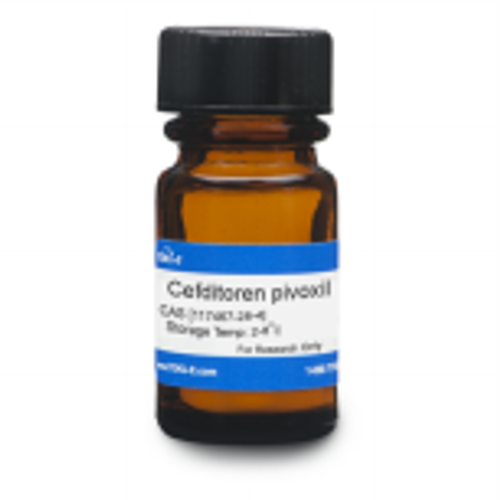Cefcapene Pivoxil Hydrochloride (monohydrate) (syn: CPHM) is a third-generation cephalosporin with antibacterial activity. This compound is the pivalate ester prodrug form of Cefcapene pivalate, which is the active form. CPHM is not water-soluble but can be converted into a water-soluble compound via esterification with trifluoroacetic acid in vitro. The compound can be used in susceptibility testing and palmoplantar pustulosis (PPP) research.
Cefcapene Pivoxil Hydrochloride is soluble in DMSO and methanol.
| Mechanism of Action | Upon hydrolysis, CPHM is converted to pivoxil in the presence of diisopropylamine and hydrochloric acid. The compound is hydrolyzed by esterase to Cefcapene. |
| Molecular Formula | C23H29N5O8S2 · HCl · H2O |
| Spectrum |
CPHM exhibits broad spectrum antibacterial activity against Gram-positive bacteria (ie. Staphylococcus aureus and Streptococcus sp.) and Gram-negative bacteria (ie E. coli, Serratia spp.). CPHM exhibits similar pharmacokinetic properties to pivoxil. |
| Eukaryotic Cell Culture Applications | Cefcapene Pivoxil Hydrochloride (CFPN-PI) was evaluated in a system using a well-established in vitro model using a monolayer of Caco-2 cells derived from human colon adenocarcinoma. In vivo, the solubility of this compound is dependent on pH due to the acidity of gastric juice, but using an in vitro system can mimic the physiological state of the human GI tract. The rate of transport across Caco-2 monolayers appeared to be linear with time. The system can predict the oral absorption of a compound that in mammals are metabolized during permeation through the intestinal epithelium (He et al, 2004). |
| Microbiology Applications |
Cefcapene is commonly used in in vitro microbiological antimicrobial susceptibility tests against Gram-positive and Gram-negative microbial isolates. Medical microbiologists use AST results to recommend antibiotic treatment options. Representative MIC values include:
Some bacteria have developed resistance mechanisms, such as producing beta-lactamase enzymes that can degrade beta-lactam antibiotics. A study looking at the stability of Cefcapene and cefpodoxime towards different beta-lactamases was conducted. Cefcapene acted as an inactivator for class C B-lactamases (Alba et al, 2002). Periapical periodontitis usually results from microbial infection. The susceptibility of 27 bacterial strains to various antimicrobial agents was evaluated. The effect of Cefcapene on 5 strains was evaluated after biofilm formation to investigate the relationship between biofilm formation and susceptibility. All strains showed a decrease in susceptibility after biofilm formation (Narita et al, 2016). |
| References |
Alba J et al (2002) Cefcapene inactivates chromosome-encoded class C β-lactamases. J. Infect. Chemother. 8:207-210 Hamamoto H et al (2005) Effects of molecular mass and hydrophobicity on transport rates through non-specific pathways of the silkworm larva midgut. Int. J. Antimicrobl Agents 26(1):38-42 He X, Sugawara M, Takekuma Y, Miyazaki K (2004) Absorption of ester prodrugs in Caco-2 and rat intestine models. Antimicrob. Agents Chemother. 48(7):2604-2609 PMID 15215116 Murakami M et al (2015) Cefcapene Pivoxil Hydrochloride is a potentially new treatment for palmoplantar pustulosis with pustulotic arthro-osteitis. Dermatology. 231(4):304-311 PMID 26440444 Narita M et al (2016) Antimicrobial susceptibility of microorganisms isolated from periapical periodontitis lesions 57(3):133-142 Zalewski P, Cielecka-Piontek J, Garbacki P, Jelińska A, Karaźniewicz-Łada M (2013) Stability-indicating HPLC method for the determination of Cefcapene Pivoxil. Chromatographia. 76(7-8):387-391 PMID 23555152 |











